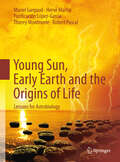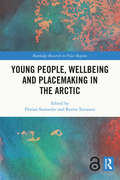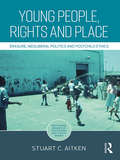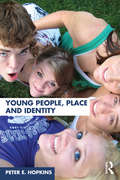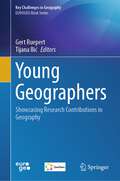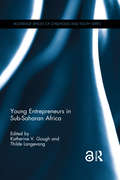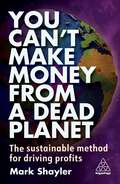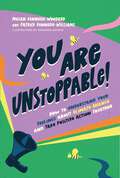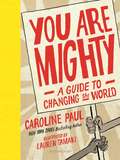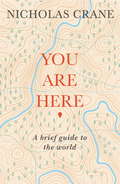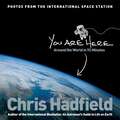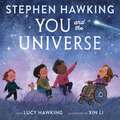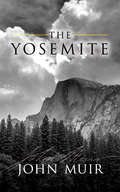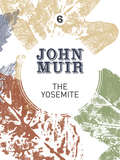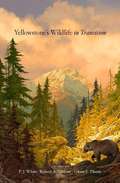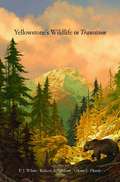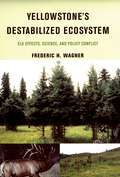- Table View
- List View
Young Sun, Early Earth and the Origins of Life: Lessons for Astrobiology
by Muriel Gargaud Hervé Martin Purificación López-García Thierry Montmerle Robert Pascal- How did the Sun come into existence? - How was the Earth formed? - How long has Earth been the way it is now, with its combination of oceans and continents? - How do you define “life”? - How did the first life forms emerge? - What conditions made it possible for living things to evolve? All these questions are answered in this colourful textbook addressing undergraduate students in "Origins of Life" courses and the scientifically interested public. The authors take the reader on an amazing voyage through time, beginning five thousand million years ago in a cloud of interstellar dust and ending five hundred million years ago, when the living world that we see today was finally formed. A chapter on exoplanets provides an overview of the search for planets outside the solar system, especially for habitable ones.The appendix closes the book with a glossary, a bibliography of further readings and a summary of the Origins of the Earth and life in fourteen boxes.
Young People, Wellbeing and Sustainable Arctic Communities (Routledge Research in Polar Regions)
by Stammler Florian Toivanen ReettaYouth are usually not (yet) decision makers in politics or in business corporations, but the sustainability of Arctic settlements depends on whether or not youth envision such places as offering opportunities for a good future. This is the first multidisciplinary volume presenting original research on Arctic youth. This edited book presents the results of two research projects on youth wellbeing and senses of place in the Arctic region. The contributions are united by their focus on agency. Rather than seeing youth as vulnerable and possible victims of decisions by others, they illustrate the diverse avenues that youth pursue to achieve a good life in the Arctic. The contributions also show which social, economic, political and legal conditions provide the best frame for youth agency in Arctic settlements. Rather than portraying the Arctic as a resource frontier, a hotspot for climate change and a place where biodiversity and traditional Indigenous cultures are under threat, the book introduces the Arctic as a place for opportunities, the realization of life trajectories and young people’s images of home. Rooted in anthropology, the chapters also feature contributions from the fields of sociology, geography, sustainability science, legal studies and political science. This book is intended for an audience interested in anthropology, political science, Arctic urban studies, youth studies, Arctic social sciences and humanities in general. It would attract those working on Arctic sustainability, wellbeing in the Arctic, Arctic demography and overall wellbeing of youth.
Young People, Wellbeing and Sustainable Arctic Communities (Routledge Research in Polar Regions)
by Florian Stammler Reetta ToivanenYouth are usually not (yet) decision makers in politics or in business corporations, but the sustainability of Arctic settlements depends on whether or not youth envision such places as offering opportunities for a good future. This is the first multidisciplinary volume presenting original research on Arctic youth. This edited book presents the results of two research projects on youth wellbeing and senses of place in the Arctic region. The contributions are united by their focus on agency. Rather than seeing youth as vulnerable and possible victims of decisions by others, they illustrate the diverse avenues that youth pursue to achieve a good life in the Arctic. The contributions also show which social, economic, political and legal conditions provide the best frame for youth agency in Arctic settlements. Rather than portraying the Arctic as a resource frontier, a hotspot for climate change and a place where biodiversity and traditional Indigenous cultures are under threat, the book introduces the Arctic as a place for opportunities, the realization of life trajectories and young people’s images of home. Rooted in anthropology, the chapters also feature contributions from the fields of sociology, geography, sustainability science, legal studies and political science. This book is intended for an audience interested in anthropology, political science, Arctic urban studies, youth studies, Arctic social sciences and humanities in general. It would attract those working on Arctic sustainability, wellbeing in the Arctic, Arctic demography and overall wellbeing of youth.
Young People, Rights and Place: Erasure, Neoliberal Politics and Postchild Ethics (Routledge Spaces of Childhood and Youth Series)
by Stuart C. AitkenConcern is growing about children’s rights and the curtailment of those rights through the excesses of neoliberal governance. This book discusses children’s spatial and citizenship rights, and the ways young people and their families push against diminished rights. Armed initially with theoretical concerns about the construction of children through the political status quo and the ways youth rights are spatially segregated, the book begins with a disarmingly simple supposition: Young people have the right to make and remake their spaces and, as a consequence, themselves. This book de-centers monadic ideas of children in favor of a post-humanist perspective, which embraces the radical relationality of children as more-than-children/more-than-human. Its empirical focus begins with the struggles of Slovenian Izbrisani (‘erased’) youth from 1992 to the present day and reaches out to child rights and youth activists elsewhere in the world with examples from South America, Eastern Europe and the USA. The author argues that universal child rights have not worked and pushes for a more radical, sustainable ethics, which dares to admit that children’s humanity is something more than we, as adults, can imagine. Chapters in this groundbreaking contribution will be of interest to students, researchers and practitioners in the social sciences, humanities and public policy.
Young People, Rights and Place: Erasure, Neoliberal Politics and Postchild Ethics (Routledge Spaces of Childhood and Youth Series)
by Stuart C. AitkenConcern is growing about children’s rights and the curtailment of those rights through the excesses of neoliberal governance. This book discusses children’s spatial and citizenship rights, and the ways young people and their families push against diminished rights. Armed initially with theoretical concerns about the construction of children through the political status quo and the ways youth rights are spatially segregated, the book begins with a disarmingly simple supposition: Young people have the right to make and remake their spaces and, as a consequence, themselves. This book de-centers monadic ideas of children in favor of a post-humanist perspective, which embraces the radical relationality of children as more-than-children/more-than-human. Its empirical focus begins with the struggles of Slovenian Izbrisani (‘erased’) youth from 1992 to the present day and reaches out to child rights and youth activists elsewhere in the world with examples from South America, Eastern Europe and the USA. The author argues that universal child rights have not worked and pushes for a more radical, sustainable ethics, which dares to admit that children’s humanity is something more than we, as adults, can imagine. Chapters in this groundbreaking contribution will be of interest to students, researchers and practitioners in the social sciences, humanities and public policy.
Young People, Place and Identity
by Peter E. HopkinsYoung People, Place and Identity offers a series of rich insights into young people’s everyday lives. What places do young people engage with on a daily basis? How do they use these places? How do their identities influence these contexts? By working through common-sense understandings of young people’s behaviours and the places they occupy, the author seeks to answer these and other questions. In doing so the book challenges and re-shapes understandings of young people’s relationships with different places and identities. The textbook is one of the first books to map out the scales, themes and sites engaged with by young people on a daily basis as they construct their multiple identities. The scales explored here include the body, neighbourhood and community, mobilities and transitions and urban-rural settings and how these all shape and are shaped by young people’s identities. Each chapter explores how social identities (such as race, gender, sexuality, class, disability and religion) are constructed within particular contexts and influenced by multiple processes of inclusion and exclusion. These discussions are supported by details of the research methods and ethical issues involved in researching young people’s lives. Drawing upon research from a range of contexts, including Europe, North America and Australasia, this book demonstrates the complex ways in which young people creatively shape, contest and resist their engagements with different places and identities. The range of issues, topics and case studies explored include: ethical and methodological issues in youth research; youth subcultures; experiences of home; territorialism; youth and crime; political engagement and participation; responses to global issues; engagements with different institutional contexts; negotiating public space; the transition to adulthood; drinking cultures. The author explores these issues through blending together original empirical research, theory and policy. Individual chapters are supported by key themes, project ideas and suggested further reading. Details of key authors, journals and research centres and organisations are also included at the end of the book. This textbook will be pertinent for undergraduate and postgraduate students and academic researchers interested in better understanding the relationships between young people, places and identities.
Young People, Place and Identity
by Peter E. HopkinsYoung People, Place and Identity offers a series of rich insights into young people’s everyday lives. What places do young people engage with on a daily basis? How do they use these places? How do their identities influence these contexts? By working through common-sense understandings of young people’s behaviours and the places they occupy, the author seeks to answer these and other questions. In doing so the book challenges and re-shapes understandings of young people’s relationships with different places and identities. The textbook is one of the first books to map out the scales, themes and sites engaged with by young people on a daily basis as they construct their multiple identities. The scales explored here include the body, neighbourhood and community, mobilities and transitions and urban-rural settings and how these all shape and are shaped by young people’s identities. Each chapter explores how social identities (such as race, gender, sexuality, class, disability and religion) are constructed within particular contexts and influenced by multiple processes of inclusion and exclusion. These discussions are supported by details of the research methods and ethical issues involved in researching young people’s lives. Drawing upon research from a range of contexts, including Europe, North America and Australasia, this book demonstrates the complex ways in which young people creatively shape, contest and resist their engagements with different places and identities. The range of issues, topics and case studies explored include: ethical and methodological issues in youth research; youth subcultures; experiences of home; territorialism; youth and crime; political engagement and participation; responses to global issues; engagements with different institutional contexts; negotiating public space; the transition to adulthood; drinking cultures. The author explores these issues through blending together original empirical research, theory and policy. Individual chapters are supported by key themes, project ideas and suggested further reading. Details of key authors, journals and research centres and organisations are also included at the end of the book. This textbook will be pertinent for undergraduate and postgraduate students and academic researchers interested in better understanding the relationships between young people, places and identities.
Young Geographers: Showcasing Research Contributions in Geography (Key Challenges in Geography)
by Gert Ruepert Tijana IlićThis book shows an updated overview of research about human geography topics like urban growth/urban challenges, transportation, landscape, land cover, geospatial analysis, regional planning/local development, cultural geography, tourism, and so on. Between 2020 and 2022, due to COVID-19 and lockdowns worldwide, there were fewer opportunities for young and upcoming researchers to present their state-of-the-art findings at conferences. In order to highlight exceptional research of young geographers during this time, the idea for this book was created. In collaboration with the EGEA alumni foundation for students and young geographers, 12 authors were selected to showcase their scientific work. In addition to that, most of them present amazing maps and figures as outstanding expression of the need of GIS for geography research.
Young Entrepreneurs in Sub-Saharan Africa (Routledge Spaces of Childhood and Youth Series)
by Katherine V. Gough Thilde LangevangYoung people in sub-Saharan Africa are growing up in rapidly changing social and economic environments which produce high levels of un- and underemployment. Job creation through entrepreneurship is currently being promoted by international organizations, governments and NGOs as a key solution, despite there being a dearth of knowledge about youth entrepreneurship in an African context. This book makes an important contribution by exploring the nature of youth entrepreneurship in Ghana, Uganda and Zambia. It provides new insights into conceptual and methodological discussions of youth entrepreneurship as well as presenting original empirical data. Drawing on quantitative and qualitative research, conducted under the auspices of a collaborative, interdisciplinary and comparative research project, it highlights the opportunities and challenges young people face in setting up and running businesses. Divided into a number of clear sections, each with its own introduction and conclusion, the book considers the nature of youth entrepreneurship at the national level, in both urban and rural areas, in specific sectors - including mobile telephony, mining, handicrafts and tourism - and analyses how key factors, such as microfinance, social capital and entrepreneurship education, affect youth entrepreneurship. New light is shed on the multi-faceted nature of youth entrepreneurship and a convincing case is presented for a more nuanced understanding of the term entrepreneurship and the situation faced by many African youth today. This book will be of interest to a wide range of scholars interested in youth entrepreneurship, including in development studies, business studies, youth studies and geography, as well as to development practitioners and policy makers. The Open Access title has now been added to the Open Access page. http://www.tandfebooks.com/page/openaccess
Young Entrepreneurs in Sub-Saharan Africa (Routledge Spaces of Childhood and Youth Series)
by Katherine V. Gough Thilde LangevangYoung people in sub-Saharan Africa are growing up in rapidly changing social and economic environments which produce high levels of un- and underemployment. Job creation through entrepreneurship is currently being promoted by international organizations, governments and NGOs as a key solution, despite there being a dearth of knowledge about youth entrepreneurship in an African context. This book makes an important contribution by exploring the nature of youth entrepreneurship in Ghana, Uganda and Zambia. It provides new insights into conceptual and methodological discussions of youth entrepreneurship as well as presenting original empirical data. Drawing on quantitative and qualitative research, conducted under the auspices of a collaborative, interdisciplinary and comparative research project, it highlights the opportunities and challenges young people face in setting up and running businesses. Divided into a number of clear sections, each with its own introduction and conclusion, the book considers the nature of youth entrepreneurship at the national level, in both urban and rural areas, in specific sectors - including mobile telephony, mining, handicrafts and tourism - and analyses how key factors, such as microfinance, social capital and entrepreneurship education, affect youth entrepreneurship. New light is shed on the multi-faceted nature of youth entrepreneurship and a convincing case is presented for a more nuanced understanding of the term entrepreneurship and the situation faced by many African youth today. This book will be of interest to a wide range of scholars interested in youth entrepreneurship, including in development studies, business studies, youth studies and geography, as well as to development practitioners and policy makers. The Open Access title has now been added to the Open Access page. http://www.tandfebooks.com/page/openaccess
You Can’t Make Money From a Dead Planet: The Sustainable Method for Driving Profits
by Mark ShaylerDoing good is no longer a luxury or a 'nice to have', it's a necessity.While businesses, both big and small, have undoubtedly caused the majority of our environmental and sustainability problems, only they can solve these issues at scale. You Can't Make Money from a Dead Planet looks at the challenges we face and shows how business needs to change in order to be the driver of the solution. Bestselling author and sustainability strategist Mark Shayler explains why there is no contradiction between being profitable and doing the right thing for the planet and doing the right thing for your customers. Providing the insights, the enthusiasm and the tools to align your business with sustainability, it blends explanations of the challenges that we face, with stories from those business that have excelled in sustainability. Exploring current sustainability approaches and trends including net-zero, circular economy, ESG, B-Corps, zero waste and environmental management systems, You Can't Make Money From a Dead Planet explains, debunks and helps you navigate the sustainable agenda while growing your business.
You Can’t Make Money From a Dead Planet: The Sustainable Method for Driving Profits
by Mark ShaylerDoing good is no longer a luxury or a 'nice to have', it's a necessity.While businesses, both big and small, have undoubtedly caused the majority of our environmental and sustainability problems, only they can solve these issues at scale. You Can't Make Money from a Dead Planet looks at the challenges we face and shows how business needs to change in order to be the driver of the solution. Bestselling author and sustainability strategist Mark Shayler explains why there is no contradiction between being profitable and doing the right thing for the planet and doing the right thing for your customers. Providing the insights, the enthusiasm and the tools to align your business with sustainability, it blends explanations of the challenges that we face, with stories from those business that have excelled in sustainability. Exploring current sustainability approaches and trends including net-zero, circular economy, ESG, B-Corps, zero waste and environmental management systems, You Can't Make Money From a Dead Planet explains, debunks and helps you navigate the sustainable agenda while growing your business.
You Are Unstoppable!: How to Understand Your Feelings about Climate Change and Take Positive Action Together
by Megan Kennedy-Woodard Dr. Patrick Kennedy-WilliamsFeeling sad, scared or angry about climate change? You are not alone. It means that you care. This book helps you harness the power of these emotions and turn them into climate action that will leave you feeling connected, motivated, and powerfully optimistic.You will learn how to:· notice and manage your eco-emotions· become a self-care champion· turn climate anxiety into climate action· inspire others to make changes· and most importantly, enjoy the climate work you do!Your journey starts today. You are unstoppable!"
You Are Unstoppable!: How to Understand Your Feelings about Climate Change and Take Positive Action Together
by Megan Kennedy-Woodard Dr. Patrick Kennedy-WilliamsFeeling sad, scared or angry about climate change? You are not alone. It means that you care. This book helps you harness the power of these emotions and turn them into climate action that will leave you feeling connected, motivated, and powerfully optimistic.You will learn how to:· notice and manage your eco-emotions· become a self-care champion· turn climate anxiety into climate action· inspire others to make changes· and most importantly, enjoy the climate work you do!Your journey starts today. You are unstoppable!"
You Are Mighty: A Guide to Changing the World
by Caroline Paul Lauren TamakiBeing a good citizen means standing up for what's right-and here's just the way to start. From the author of The Gutsy Girl, this kids' guide to activism is the perfect book for those with a fierce sense of justice, a good sense of humor, and a big heart. This guide features change-maker tips, tons of DIY activities, and stories about the kids who have paved the way before, from famous activists like Malala Yousafzai and Claudette Colvin to the everyday young people whose habit changes triggered huge ripple effects. So make a sign, write a letter, volunteer, sit-in, or march! There are lots of tactics to choose from, and you're never too young to change the world.
You Are Here: A Brief Guide to the World
by Nicholas CraneOne word binds us all: geography. We are all geographers, human beings who care about the places we think of as 'home' - our habitat. And yet we have lost touch with the connection between our actions and the state of the planet that we all share. We need a new narrative that restores the connections between humanity and the Earth.We are being confronted by a daily barrage of geographical stories on climate change, geopolitics, population growth, migration, dwindling resources, polluted oceans and natural hazards. These are planetary concerns affecting all people and all places. They are challenges which can be addressed through geography.In this distillation of a lifetime's work, Nicholas Crane makes the compelling case that never has geography been so important. On this finite orb, with its battered habitat, sustained in dark space by a thin, life-giving atmosphere, we have reached a point in our collective geographical journey where knowledge is the best guarantor of the future.
You Are Here: Around the World in 92 Minutes
by Chris HadfieldIn You Are Here, celebrated astronaut Chris Hadfield gives us the really big picture: this is our home, as seen from space. The millions of us who followed Hadfield's news-making Twitter feed from the International Space Station thought we knew what we were looking at when we first saw his photos. But we may have caught the beauty and missed the full meaning. Now, through photographs – many of which have never been shared – Hadfield unveils a fresh and insightful look at our planet. He sees astonishing detail and importance in these images, not just because he's spent months in space but because his in-depth knowledge of geology, geography and meteorology allows him to reveal the photos' mysteries.Featuring Hadfield's favourite images, You Are Here is divided by continent and represents one (idealized) orbit of the ISS. Surprising, thought-provoking and visually delightful, it opens a singular window on our planet, using remarkable photographs to illuminate the history and consequences of human settlement, the magnificence of never-before-noticed landscapes, and the power of the natural forces shaping our world and the future of our species.
You and the Universe
by Lucy Hawking Stephen Hawking'We are all time-travellers, journeying together into the future. Be brave. Be determined. Let's work together to make that future a place we want to visit.'Based on Professor Hawking's 2018 Earth Day address, this inspiring picture asks children everywhere to look up and wonder at the world around them - just as Professor Hawking did his whole life. Including questions and answers to some big science topics, perfectly explained for young readers by Professor Hawking's daughter, Lucy, and beautifully illustrated by Xin Li, this is the perfect read for curious minds.
The Yosemite: Illustrated Edition (Mobi Classics Series)
by John MuirAn essential companion for visitors, this book by the famed conservationist offers informed appraisals of Yosemite's plant and animal life and exudes an almost mystical love for its natural beauty.
The Yosemite: John Muir's quest to preserve the wilderness (John Muir: The Eight Wilderness-Discovery Books #3)
by John Muir‘All these colours, from the blue sky to the yellow valley smoothly blending as they do in a rainbow, making a wall of light ineffably fine.’Having spent significant time obsessively exploring and learning about the Sierra, John Muir’s passion for and belief in preserving the wilderness steadily grew. He believed that excessive grazing and logging would result in its eventual destruction, and so campaigned to designate the area as a protected national park.In 1890, the US Congress passed the National Park Bill, and the Yosemite and Sequoia national parks were established. At the time of writing, Muir’s views on conservation of the wilderness were totally radical; today, environmental activists are too often brushed aside in favour of something faster, easier, and cheaper.Muir not only educates us in the particulars of the botanicals of this spectacular landscape, but also inadvertently traps us in his web of enthusiasm for the beauty and significance of Mother Nature. The Yosemite gives us the tools to construct a detailed mental map of the Sierra, and leaves us with the resolution to be more compassionate and environmentally mindful.First published in 1912, and with a new introduction from Muir authority Terry Gifford, the message in The Yosemite is perhaps more pertinent now than it ever was. There is a lot to thank Muir for, not least opening our eyes to the earth beneath our feet.
Yorkshire Dales National Park (tactile)
by RnibThis is a tactile diagram for GCSE level students. It consists for three pages: the first page is a key, with tactile symbols and labels explained, the second page shows a map of the Yorkshire Dales National Park, with roads, towns and railway.
Yorck and the Era of Prussian Reform
by Peter ParetA new view of the years of Prussian reform is presented here, showing the military impact of Revolutionary and Napoleonic France on Prussia, the nature of the challenge, the efforts of Prussian institutions and society to master the new situation, the obstacles, and changes.Originally published in 1966.The Princeton Legacy Library uses the latest print-on-demand technology to again make available previously out-of-print books from the distinguished backlist of Princeton University Press. These editions preserve the original texts of these important books while presenting them in durable paperback and hardcover editions. The goal of the Princeton Legacy Library is to vastly increase access to the rich scholarly heritage found in the thousands of books published by Princeton University Press since its founding in 1905.
Yellowstone's Wildlife in Transition
by P. J. WhiteThe world's first national park is constantly changing. How we understand and respond to recent events putting species under stress will determine the future of ecosystems millions of years in the making. Marshaling expertise from over 30 contributors, Yellowstone's Wildlife in Transition examines three primary challenges to the park's ecology.
Yellowstone's Wildlife in Transition
by P. J. WhiteThe world's first national park is constantly changing. How we understand and respond to recent events putting species under stress will determine the future of ecosystems millions of years in the making. Marshaling expertise from over 30 contributors, Yellowstone's Wildlife in Transition examines three primary challenges to the park's ecology.
Yellowstone's Destabilized Ecosystem: Elk Effects, Science, and Policy Conflict
by Frederic H. WagnerWagner, one of our most distinguished wildlife biologists, is a strong critic of ecological practices in the national parks. This book provides an assessment of the ecological history of Yellowstone's northern range, since before the park existed, showing the impact of US Park Service policies on the health of the areas they oversee. He demonstrates that elk had been historically rare throughout the region and that overgrazing by elk has seriously degraded the landscape and altered the structure of the area. This is a major contribution to reconstructing the ecology of this region over the course of the past 500 years. It is also a critique of US Park Service management policies and their stewardship of the nation's most cherished natural areas. Wagner's book will generate substantial attention and debate both in the scientific and policy/management communities.
